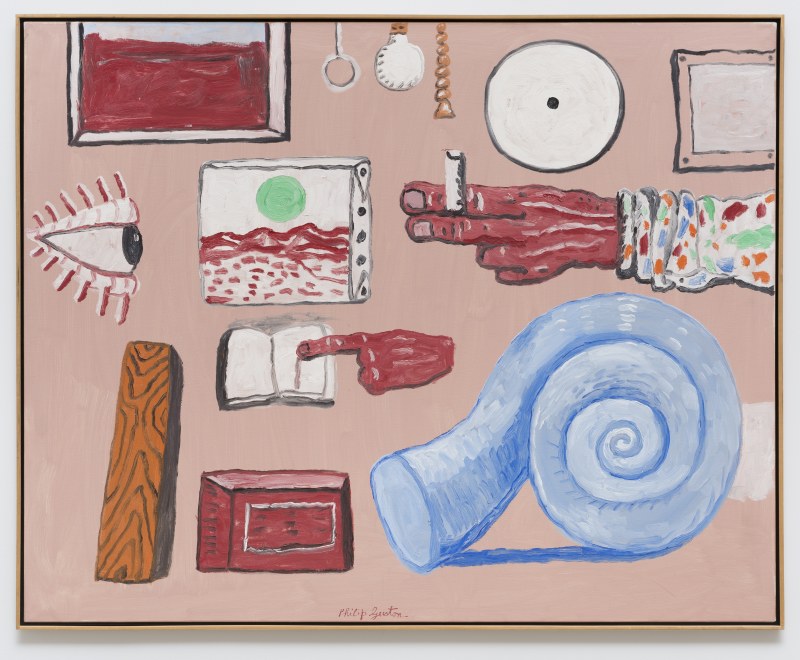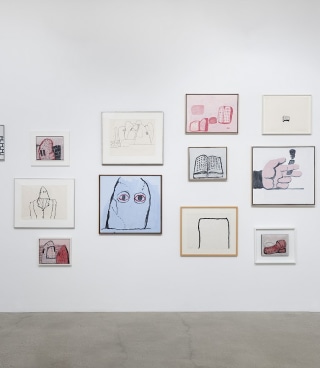Philip Guston: Objects
Past exhibition
Overview
Sometimes when my painting is getting too artistic, I’ll say to myself, “What if the shoe salesman asked you to paint a shoe on his window?” Suddenly everything lightens. I feel not so responsible and paint directly what the thing is, including the necessary distortions’
Philip Guston
The Timothy Taylor Gallery is delighted to announce an unusual exhibition of paintings and works on paper dating from the early 1950’s through to the late 1970’s which present an insight into the mechanics of Guston’s mind and method, clearly charting his development of a new way of seeing from abstraction through to a ground-breaking artistic inventory of forms.
Focusing on the object in Guston’s work, this exhibition shows the emergence of form in his drawings and paintings of the 50’s and 60’s, culminating with the invention of an alphabet of crude, tragic-comic images from life that become so distinct in the 70’s. ‘Leaving’ (1950), a quill and ink drawing on paper, is a delicate abstract work, but up close the drawing reveals early signs of an intuitive handling of form. ‘Sleeper III’ (1960) is at first glance abstract, however upon closer inspection the figure of a man gradually emerges, almost adopting the classical pose of Rodin’s ‘The Thinker’.
Seldom seen smaller works such as ‘Untitled (Book)’ (1969), in acrylic on panel gives a remarkable insight into the conception of the individual forms that combine to make the large scale canvases. We see forms over-painted by the artist with lively brush strokes as he pushes the boundaries of figurative painting, seeing familiar objects with fresh eyes. Arriving at ‘Story’ (1978), we are presented with a barren, Beckett-like landscape, populated by a clear selection of cartoon-like objects: a hand holding a cigarette, an Egyptian-style eye, a book, a light-bulb, a rope and a canvas. It becomes the culmination of Guston’s surreal inventory of recurring images.
Guston’s creation of an existential pictorial alphabet from the simple everyday object, and his brave, ground-breaking dialogue between abstraction and figuration has influenced a whole generation of later artists from Francesco Clemente to Jean Michel Basquiat, Georg Baselitz to Fiona Rae.
‘He had found a way to create paintings that leapt the boundary of “painting”, and entered life’
Andrew Graham-Dixon
The Timothy Taylor Gallery is delighted to announce an unusual exhibition of paintings and works on paper dating from the early 1950’s through to the late 1970’s which present an insight into the mechanics of Guston’s mind and method, clearly charting his development of a new way of seeing from abstraction through to a ground-breaking artistic inventory of forms.
Focusing on the object in Guston’s work, this exhibition shows the emergence of form in his drawings and paintings of the 50’s and 60’s, culminating with the invention of an alphabet of crude, tragic-comic images from life that become so distinct in the 70’s. ‘Leaving’ (1950), a quill and ink drawing on paper, is a delicate abstract work, but up close the drawing reveals early signs of an intuitive handling of form. ‘Sleeper III’ (1960) is at first glance abstract, however upon closer inspection the figure of a man gradually emerges, almost adopting the classical pose of Rodin’s ‘The Thinker’.
Seldom seen smaller works such as ‘Untitled (Book)’ (1969), in acrylic on panel gives a remarkable insight into the conception of the individual forms that combine to make the large scale canvases. We see forms over-painted by the artist with lively brush strokes as he pushes the boundaries of figurative painting, seeing familiar objects with fresh eyes. Arriving at ‘Story’ (1978), we are presented with a barren, Beckett-like landscape, populated by a clear selection of cartoon-like objects: a hand holding a cigarette, an Egyptian-style eye, a book, a light-bulb, a rope and a canvas. It becomes the culmination of Guston’s surreal inventory of recurring images.
Guston’s creation of an existential pictorial alphabet from the simple everyday object, and his brave, ground-breaking dialogue between abstraction and figuration has influenced a whole generation of later artists from Francesco Clemente to Jean Michel Basquiat, Georg Baselitz to Fiona Rae.
‘He had found a way to create paintings that leapt the boundary of “painting”, and entered life’
Andrew Graham-Dixon

